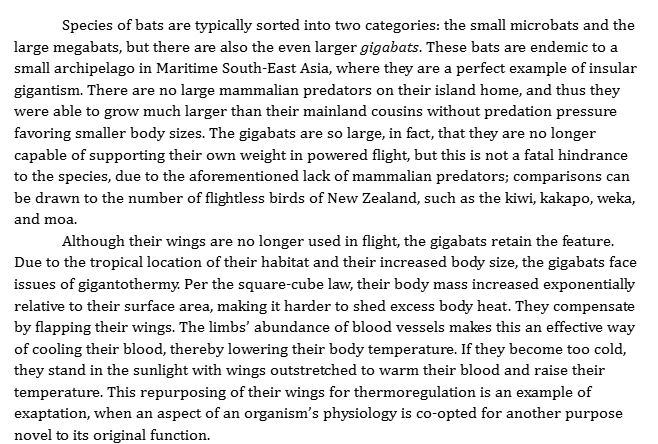What a cool concept! Excited to know there are more speculative terrestrial bats coming!
26.10.2025 10:50 — 👍 1 🔁 0 💬 0 📌 0Ben G Thomas
@bengthomas.bsky.social
@bengthomas.bsky.social
What a cool concept! Excited to know there are more speculative terrestrial bats coming!
26.10.2025 10:50 — 👍 1 🔁 0 💬 0 📌 0
Species of bats are typically sorted into two categories: the small microbats and the large megabats, but there are also the even larger gigabats. These bats are endemic to a small archipelago in Maritime South-East Asia, where they are a perfect example of insular gigantism. There are no large mammalian predators on their island home, and thus they were able to grow much larger than their mainland cousins without predation pressure favoring smaller body sizes. The gigabats are so large, in fact, that they are no longer capable of supporting their own weight in powered flight, but this is not a fatal hindrance to the species, due to the aforementioned lack of mammalian predators; comparisons can be drawn to the number of flightless birds of New Zealand, such as the kiwi, kakapo, weka, and moa. Although their wings are no longer used in flight, the gigabats retain the feature. Due to the tropical location of their habitat and their increased body size, the gigabats face issues of gigantothermy. Per the square-cube law, their body mass increased exponentially relative to their surface area, making it harder to shed excess body heat. They compensate by flapping their wings. The limbs’ abundance of blood vessels makes this an effective way of cooling their blood, thereby lowering their body temperature. If they become too cold, they stand in the sunlight with wings outstretched to warm their blood and raise their temperature. This repurposing of their wings for thermoregulation is an example of exaptation, when an aspect of an organism’s physiology is co-opted for another purpose novel to its original function.

Recent analysis of gigabat vocalizations and social interactions suggests an additional secondary purpose for their wings: acting as amplifying devices for intraspecific communication across long distances, like an anatomical satellite dish. The gigabats also flap their wings to maintain balance when foraging with their dexterous feet. Another adaptation of the gigabats is long legs. Part of “normal” bats’ unusual morphology is knees which bend backwards, giving them stork-like proportions and the gait of a wading bird, but unlike birds, gigabats are knuckle-walkers. By walking on their knuckles, they preserve their long claws, which they use in conjunction with their highly mobile ankles for foraging.
I just watched the new @bengthomas.bsky.social video about speculative bat evolution and it reminded me of a piece I wrote for a larger spec-zoo project that I can't say *too much* about. Here's the batty bit though:
#Biology🦇
This is one of the most accurate coverage of the study I’ve seen (including written articles), it really deserves to be shared with both scientists and non-scientists!
15.09.2025 19:03 — 👍 4 🔁 1 💬 0 📌 0
If you’ve heard about our study on ants producing two different species but are still confused about how it works (and don’t have time to read the paper), this 10-minute video made by @bengthomas.bsky.social is very informative:
www.youtube.com/watch?v=Z-O4...
Paper: www.nature.com/articles/s41...
Thank you! I'm happy that you liked my coverage of the paper, and congratulations on publishing such an incredible study!
15.09.2025 18:11 — 👍 2 🔁 0 💬 1 📌 0I hope you love him!! :D
10.03.2025 22:23 — 👍 2 🔁 0 💬 1 📌 0
A photo of a plush dinosaur. The plush dinosaur is a blue spinosaurus, with a cream belly and red sails being barely visible. It has for eyes and a single visible tooth. The plush is is being held upright by the photographer's hand. A green plush dragon and a knitted cardigan are in the background.

Another photo of the same plush dinosaur. The plush dinosaur is propped against a wall. The red sails on its head and back are visible at this new angle. The back sail also has two large green dots that can be seen.
He finally came! I've been following the Ben G Thomas Youtube channel (@bengthomas.bsky.social) and the 7 Days of Science videos for a while. It's only today that this little guy came in the mail. I'm so glad he's finally arrived!! 😊💜💜 Please check out their channel and support them as best you can!
10.03.2025 21:32 — 👍 8 🔁 1 💬 1 📌 0